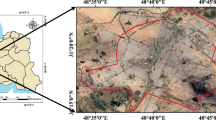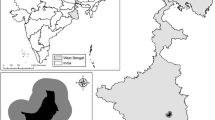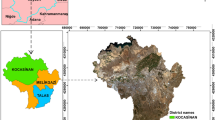Abstract
Urban expansion can cause extensive changes in land use and land cover (LULC), leading to changes in temperature conditions. Land surface temperature (LST) is one of the key parameters that should be considered in the study of urban temperature conditions. The purpose of this study was, therefore, to investigate the effects of changes in LULC due to the expansion of the city of Isfahan on LST using landscape metrics. To this aim, two Landsat 5 and Landsat 8 images, which had been acquired, respectively, on August 2, 1985, and July 4, 2015, were used. The support vector machine method was then used to classify the images. The results showed that Isfahan city had been encountered with an increase of impervious surfaces; in fact, this class covered 15% of the total area in 1985, while this value had been increased to 30% in 2015. Then LST zoning maps were created, indicating that the bare land and impervious surfaces categories were dominant in high temperature zones, while in the zones where water was present or NDVI was high, LST was low. Then, the landscape metrics in each of the LST zones were analyzed in relation to the LULC changes, showing that LULC changes due to urban expansion changed such landscape properties as the percentage of landscape, patch density, large patch index, and aggregation index. This information could be beneficial for urban planners to monitor and manage changes in the LULC patterns.







Similar content being viewed by others
References
Alberti, M., & Marzluff, J. (2004). Ecological resilience in urban ecosystems: linking urban patterns to ecological and human function. Urban Ecosystem, 7(3), 241–265.
Artis, D. A., & Carnahan, W. H. (1982). Survey of emissivity variability in thermography of urban areas. Remote Senseng of Environment, 12, 313–329.
Asgarian, A., Amiri, B. J., & Sakieh, Y. (2015). Assessing the effect of green cover spatial patterns on urban land surface temperature using landscape metrics approach. Urban Ecosystem, 18, 209–222.
Bain, D. J., & Brush, G. S. (2004). Placing the pieces: reconstructing the original property mosaic in a warrant and patent watershed. Landscape Ecology, 19(8), 843–856.
Chavez, P. S. (1996). Image-based atmospheric corrections—revisited and improved. Photogrammetric Engineering and Remote Sensing, 62(9), 1025–1036.
Gallo, K. P., McNab, A. L., Karl, T. R., Brown, J. F., Hood, J. J., & Tarpley, J. D. (1993). The use of a vegetation index for assessment of the urban heat island effect. International Journal of Remote Sensing, 14(11), 2223–2230.
Ghobadi, Y., Pradhan, B., Shafri, H. Z. M., & Kabiri, K. (2015). Assessment of spatial relationship between land surface temperature and landuse/cover retrieval from multi-temporal remote sensing data in South Karkheh Sub-basin, Iran. Arabian Journal of Geosciences, 8, 525–537.
Iran Meteorological Organization (n.d.) http://www.irimo.ir/.
Jiménez-Muñoz, J. C., Sobrino, J. A., Skoković, D., Mattar, C., & Cristóbal, J. (2014). Land surface temperature retrieval methods from Landsat-8 thermal infrared sensor data. IEEE Geoscience and Remote Sensing Letters, 11, 1840–1843.
Keshtkar, H., & Voigt, W. (2016). Potential impacts of climate and landscape fragmentation changes on plant distributions: coupling multitemporal satellite imagery with GIS-based cellular automata model. Ecological Informatics, 32, 145–155.
Leo, N. D., Escobedo, F. J., & Dubbeling, M. (2016). The role of urban green infrastructure in mitigating land surface temperature in Bobo-Dioulasso, Burkina Faso. Environment, Development and Sustainability, 18, 373–392.
Li, X., Zhou, W., & Ouyang, Z. (2013). Relationship between land surface temperature and spatial pattern of greenspace: what are the effects of spatial resolution? Landscape and Urban Planning, 114, 1–8.
Liu, H., & Weng, Q. (2008). Seasonal variations in the relationship between landscape pattern and land surface temperature in Indianapolis, USA. Environmental Monitoring and Assessment, 144(1), 199–219.
Liu, H., & Weng, Q. (2009). Scaling effect on the relationship between landscape pattern and land surface temperature: a case study of Indianapolis, United States. Photogrammetric Engineering & Remote Sensing, 75(3), 291–304.
Lo, C. P., & Quattrochi, D. A. (2003). Land-use and land-cover change, urban heat island phenomenon, and health implications: a remote sensing approach. Photogrammetric Engineering and Remote Sensing, 69, 1053–1063.
Mantero, P., Moser, G., & Serpico, S. B. (2005). Partially supervised classification of remote sensing images through SVM-based probability density estimation. IEEE Transactions on Geoscience and Remote Sensing, 43(3), 559–570.
McGarigal, K. (2015). Fragstats help. Amherst: Department of Environmental Conservation University of Massachusetts.
McGarigal, K., & Marks, B. J. (1995). FRAGSTATS: spatial pattern analysis program for quantifying landscape structure. Gen. Tech. Report PNW-GTR-351, USDA Forest Service, Pacific Northwest Research Station, Portland, OR.
Memon, R. A., Leung, D. Y., & Chunho, L. (2008). A review on the generation, determination and mitigation of Urban Heat Island. Journal of Environmental Sciences, 20, 120–128.
Quattrochi, D. A., & Luvall, J. C. (1999). Thermal infrared remote sensing for analysis of landscape ecological processes: methods and applications. Landscape Ecology, 14(6), 577–598.
Smith, R. M. (1986). Comparing traditional methods for selecting class intervals on choropleth maps. The Professional Geographer, 38(1), 62–67.
Statistical Center of Iran. (2011). Iran statistical yearbook. https://www.amar.org.ir/.
Turner, M. G. (1990). Spatial and temporal analysis of landscape patterns. Landscape Ecology, 4, 21–30.
Turner, M. G. (2005). Landscape ecology: what is the state of the science? Annual Review of Ecological Evolution and Sensing, 36, 319–344.
United Nations. (2014). World urbanization prospects: the 2014 revision. New York.
Valor, E., & Caselles, V. (1996). Mapping land surface emissivity from NDVI: application to European, African and South American areas. Remote Sensing of Environment, 57, 167–184.
Voogt, J. A., & Oke, T. R. (1997). Complete urban surface temperatures. Journal of Applied Meteorology, 36, 1117–1132.
Wan, Z. (1999). MODIS Land-Surface Temperature Algorithm Theoretical Basis Document (LST ATBD) version 3.3. Santa Barbara: Institute for Computational Earth System Science, University of California.
Weng, Q. (2009). Thermal infrared remote sensing for urban climate and environmental studies: methods, applications, and trends. ISPRS Journal of Photogrammetry and Remote Sensing, 64, 335–344.
Weng, Q., Liu, H., & Lu, D. (2007). Assessing the effects of land use and land cover patterns on thermal conditions using landscape metrics in city of Indianapolis, United States. Urban Ecosystems, 10(2), 203–219.
Weng, Q., Lu, D., & Schubring, J. (2004). Estimation of land surface temperature–vegetation abundance relationship for urban heat island studies. Remote Sensing of Environment, 89(4), 467–483.
Wu, J., Jelinski, D. E., Luck, M., & Tueller, P. T. (2000). Multiscale analysis of landscape heterogeneity: scale variance and pattern metrics. Geographic Information Sciences, 6(1), 6–19.
Xie, M., Wang, Y., Chang, Q., Fu, M., & Ye, M. (2013). Assessment of landscape patterns affecting land surface temperature in different biophysical gradients in Shenzhen, China. Urban Ecosystem, 16, 871–886.
Zhang, J., & Wang, Y. (2008). Study of the relationships between the spatial extent of surface urban heat islands and urban characteristic factors based on Landsat ETM+ data. Sensors, 8, 7453–7468.
Zhang, Y., Odehb, I. O. A., & Ramadanc, E. (2013). Assessment of land surface temperature in relation to landscape metrics and fractional vegetation cover in an urban/peri-urban region using Landsat data. International Journal of Remote Sensing, 34(1), 168–189.
Zhou, W., Huang, G., & Cadenasso, M. L. (2011). Does spatial configuration matter? Understanding the effects of land cover pattern on land surface temperature in urban landscapes. Landscape and Urban Planning, 102, 54–63.
Zhou, W., Qian, Y., Li, X., Li, W., & Han, L. (2014). Relationships between land cover and the surface urban heat island: seasonal variability and effects of spatial and thematic resolution of land cover data on predicting land surface temperatures. Landscape Ecology, 29, 153–167.
Acknowledgements
This research has been supported by the Isfahan University of Technology.
Author information
Authors and Affiliations
Corresponding author
Rights and permissions
About this article
Cite this article
Madanian, M., Soffianian, A.R., Koupai, S.S. et al. Analyzing the effects of urban expansion on land surface temperature patterns by landscape metrics: a case study of Isfahan city, Iran. Environ Monit Assess 190, 189 (2018). https://doi.org/10.1007/s10661-018-6564-z
Received:
Accepted:
Published:
DOI: https://doi.org/10.1007/s10661-018-6564-z




